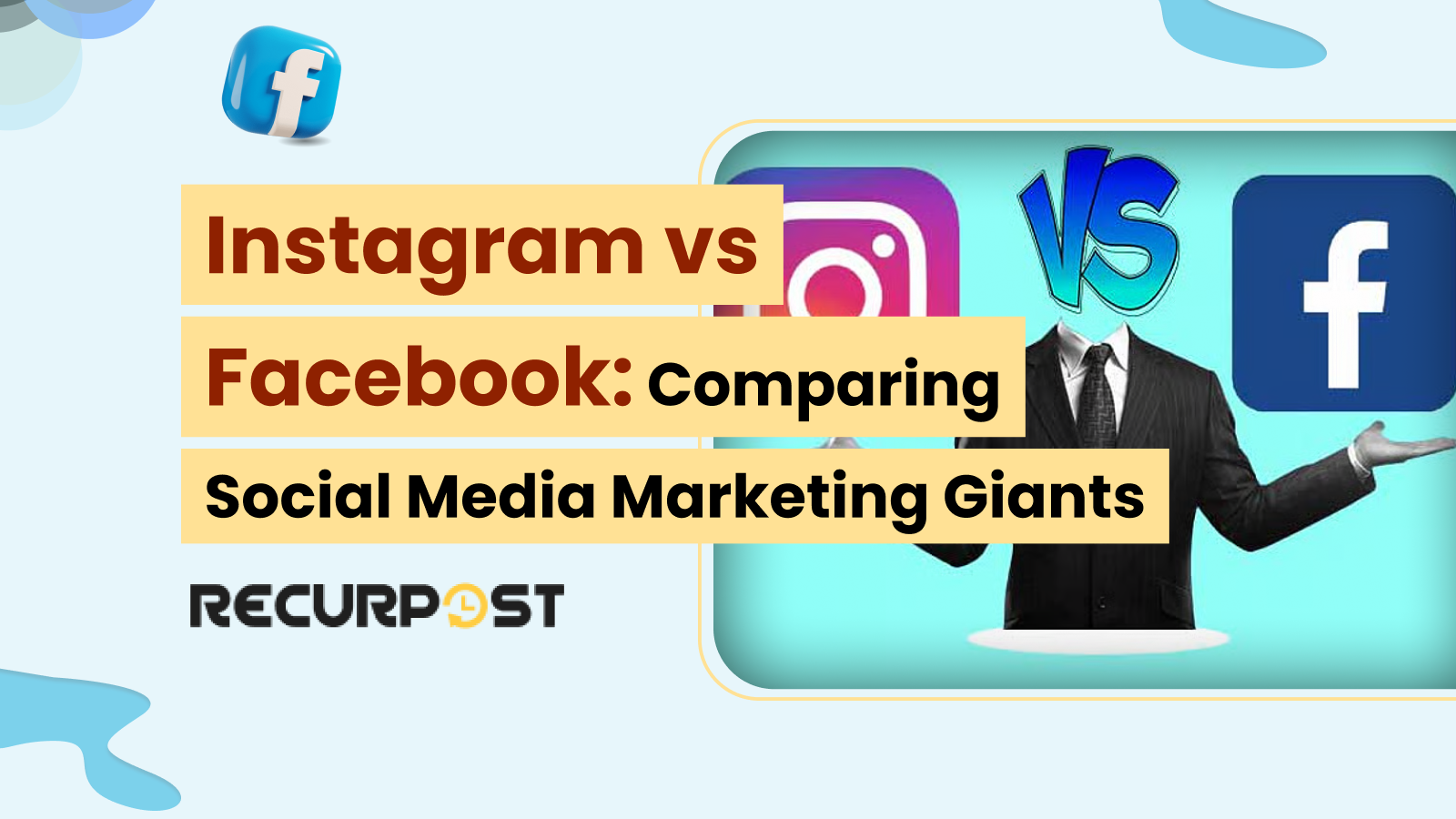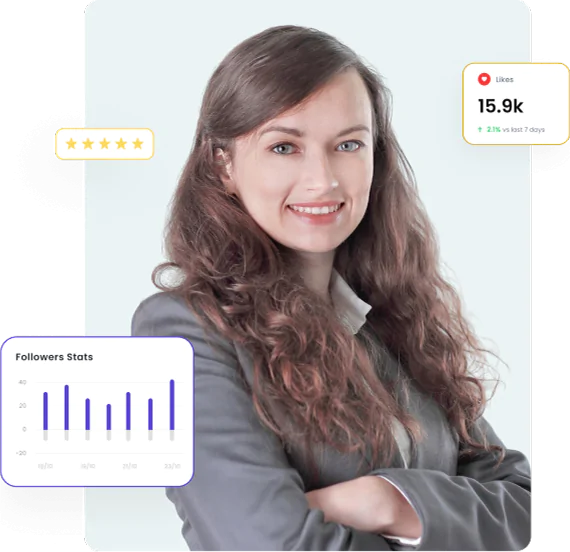Instagram vs Facebook: Which is the right choice for your marketing goals?
Choosing between Facebook and Instagram shapes how your brand connects, engages, and grows on these two dominant social media platforms. Though both are Meta products, each offers unique user habits, ad tools, and content formats.
In 2025, Facebook boasts 3.07 billion monthly active users, while Instagram draws in 2 billion. That user gap shapes how marketers plan. Instagram vs Facebook performance diverges: Facebook wins on ad targeting capabilities, while Instagram pulls ahead in engagement rate and visual-first appeal. Their user bases are split by age, too- Gen Z and Millennials lean toward Instagram, while Gen X and Baby Boomers remain strong on Facebook.
We’ll break down essential metrics: user behavior patterns, engagement metrics, ad results, and how each platform fits your brand’s needs. This Instagram vs Facebook comparison will help you choose wisely for 2025.
Instagram vs Facebook: In 2025
| Aspect | ||
| Monthly Active Users (2025) | 3.07 billion | 2.0 billion |
| User Base Growth (2019-2025) | Steady growth | Rapid growth from 1 million to 2 billion |
| Age Demographics | Older audience (Gen X, Baby Boomers) | Younger audience (Gen Z, Millennials) |
| Gender Split | 56.8% Male, 43.2% Female (global) | 50.6% Male, 49.4% Female (global) |
| Top Countries by User Count | India, U.S., Brazil, Indonesia, Turkey | India, U.S., Brazil, Indonesia, Turkey |
| Average Time Spent (Monthly) | 18 hours 45 mins | 12 hours |
| Engagement Rate (Per Post) | 1.06% | 5.03% |
| Post Interactions (Avg.) | 28 | 162 |
| Cost Per Click (CPC) | $0.49 | $1.09 |
| Click-Through Rate (CTR) | 3.06% | 0.68% |
| Top Content Formats | Text-based posts, Videos, Live, Links | Visual content (Images, Carousels, Reels) |
| Mobile vs Desktop Usage | Cross-device (Mobile, Desktop, Tablet) | Mobile-first design |
| Ad Formats | Feed, Messenger, Stories, Marketplace | Feed, Stories, Reels, Shopping Tags |
| Best For | Lifestyle brands, visual storytelling, and fashion | Lifestyle brands, visual storytelling, fashion |
| Ad Targeting | Advanced demographic, behavioral, and interest targeting | Interest-based targeting (visual audience) |
| eCommerce Integration | Facebook Shops (broad access) | Instagram Shop (restricted access) |
User Base and Audience Demographics in 2025
The Instagram vs Facebook user base in 2025 creates unique marketing opportunities. Both platforms, powered by Meta, highlight noticeable audience demographics that affect how your campaigns perform.
Monthly Active Users: Instagram vs Facebook
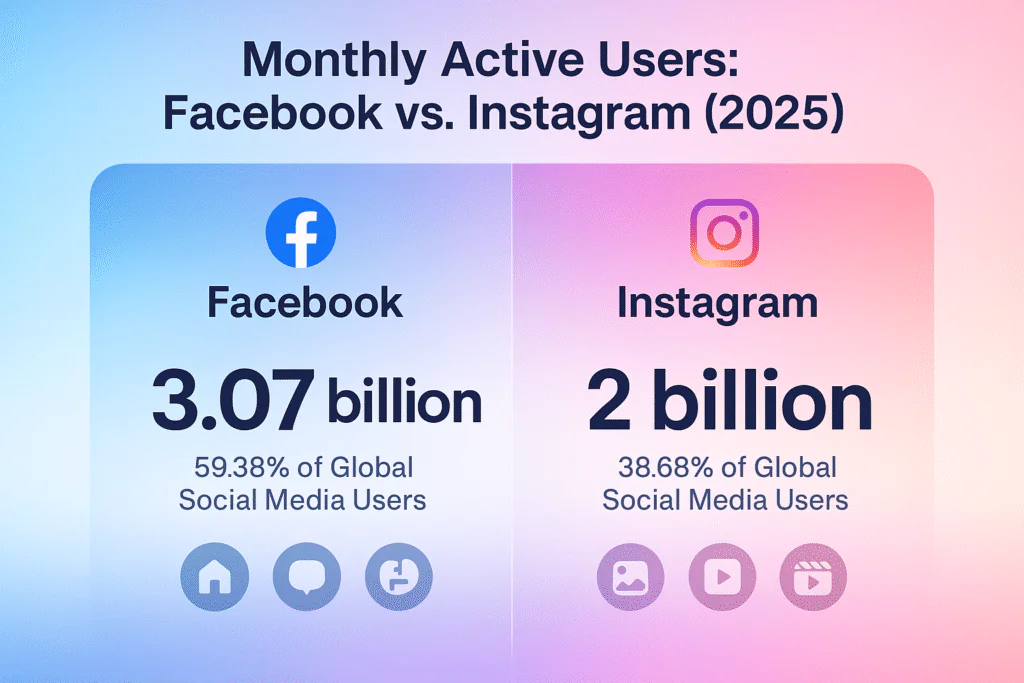
Facebook leads global social media platforms in 2025 with 3.07 billion monthly active users, while Instagram claims 2 billion. This 1 billion difference in user count influences how businesses choose between platforms.
Growth trends show diverging paths: Facebook expanded steadily from 2.4 billion in 2021, while Instagram’s user growth rate soared, hitting 2 billion after launching with 1 million users in just 2.5 months.
These 2025 figures reflect strong global market penetration. Facebook users make up 59.38% of global social network participants; Instagram users account for 38.68% – a wide split with major campaign performance implications.
Age Distribution
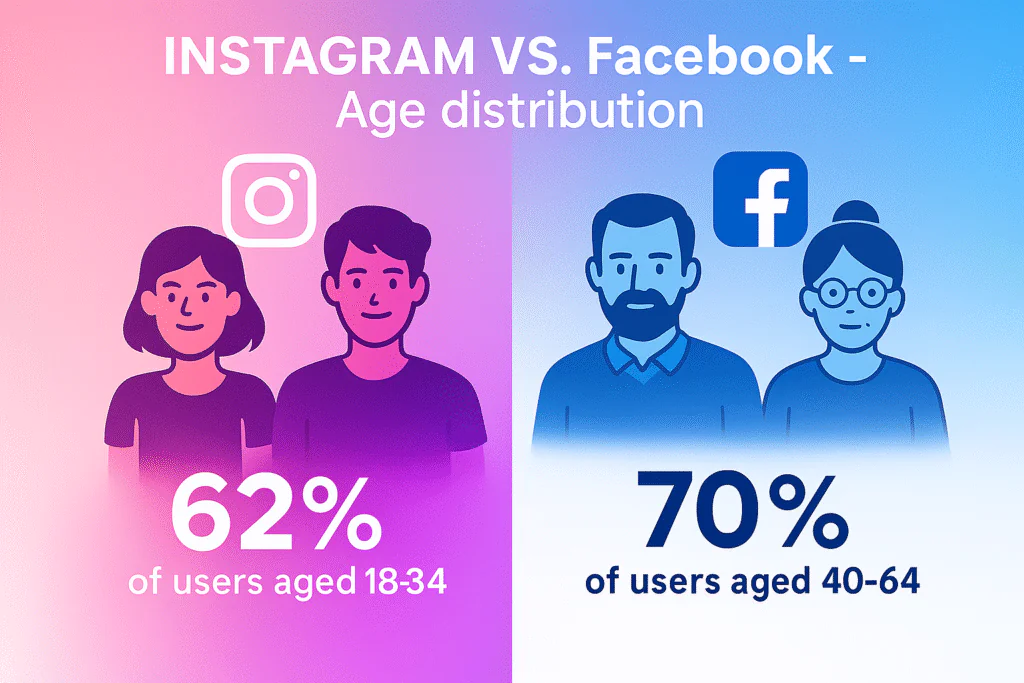
The age demographics vary sharply. Instagram captures younger audiences: 62% of users are 18-34. Gen Z (18–24) forms 31.3%, while Millennials (25–34) represent 31%, showcasing the platform’s appeal to the younger generation.
Facebook caters more to older users. Its largest group is men aged 25–34 (18.5%), but its strongest hold is among older age groups: 70% of U.S. users aged 50–64 and 59% aged 65+ use the platform. For brands targeting Gen X and Baby Boomers, Facebook offers unmatched reach.
Gender Split
Gender data also shows clear differences. Facebook’s gender split is 56.8% male to 43.2% female, while Instagram shows more balance with 50.6% male and 49.4% female users.
Regionally, it shifts. In the U.S., both apps have more female users. Instagram’s U.S. audience is 55.4% female; Facebook’s is even higher at 78% among users aged 30–49. These trends are key for target audience planning.
For marketing campaigns targeting U.S. women, either platform works well. But globally, Facebook’s male-heavy audience is worth considering during audience targeting.
Top Countries by User Count
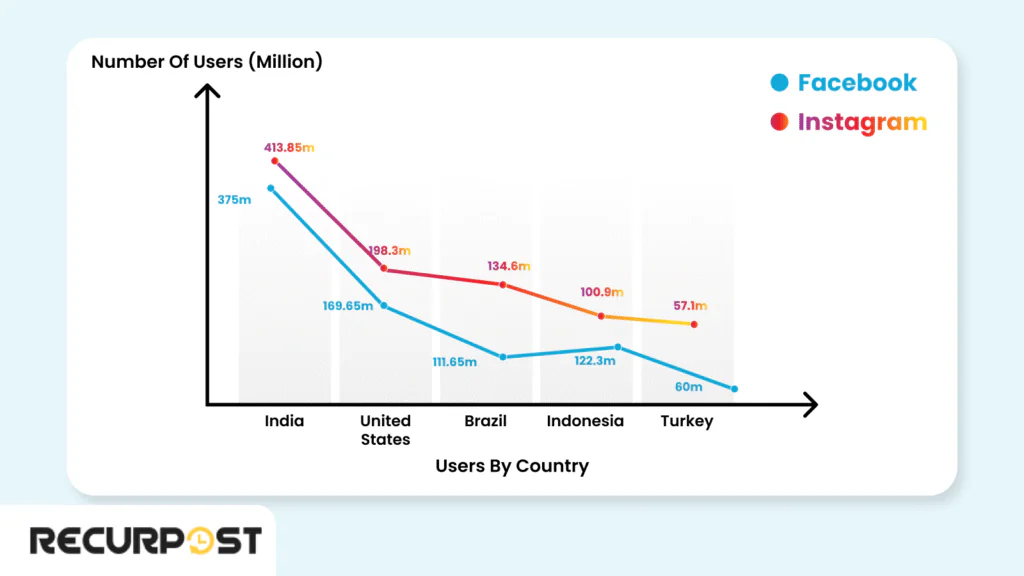
India tops both Facebook and Instagram in total users, with 375 million on Facebook and 413.85 million on Instagram—making it the most active country on either platform. This reflects the region’s massive social media growth.
The United States ranks second, with 198.3 million Facebook users and 169.65 million Instagram users. Brazil ranks third, with 111.65 million on Facebook and 134.6 million on Instagram, showing stronger Instagram engagement.
Indonesia continues as a key market: 122.3 million on Facebook, 100.9 million on Instagram. Turkey rounds out the top five, with 60 million Facebook and 57.1 million Instagram users, supporting global regional user distribution.
These top countries by user count—especially India—present vast potential for brands to reach diverse audiences and build platform-specific content strategies.
Engagement Metrics and User Behavior
Instagram vs Facebook user behavior shows different interaction styles, shaping your social media strategy and content approach.
Average Time Spent
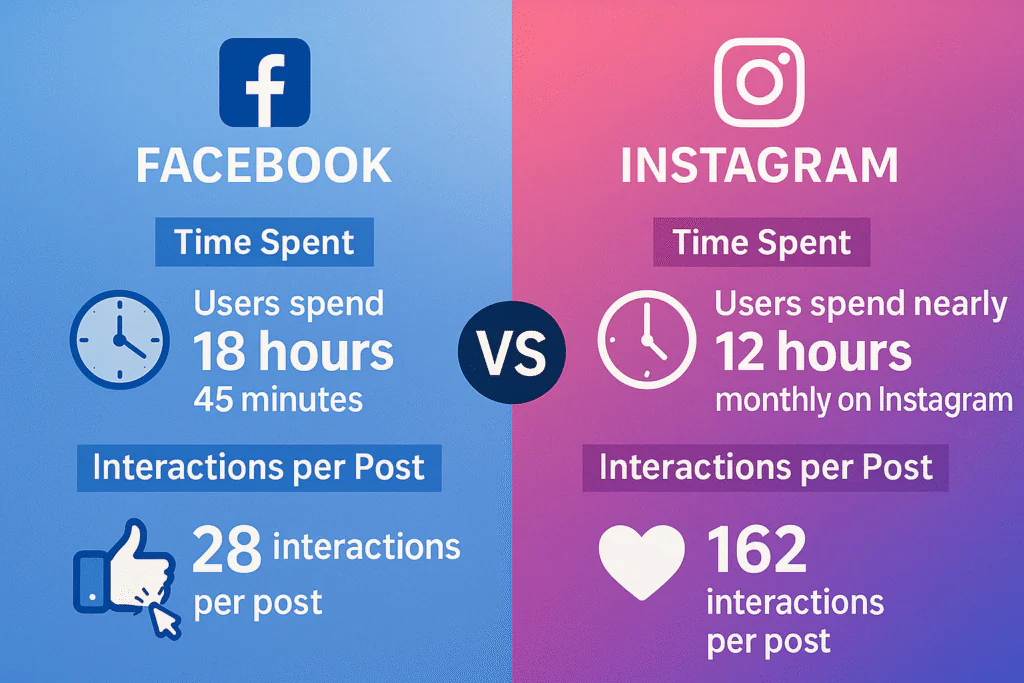
Time spent on platforms directly correlates with marketing effectiveness. Facebook users spend 18 hours and 45 minutes monthly on the platform.
Instagram drives stronger engagement despite its smaller user base. Users across the globe spent nearly 12 hours each month using the Instagram mobile app. Users check Instagram 351 times monthly, creating multiple daily opportunities to see content. WhatsApp tops the list for app opens, with users checking it 930 times monthly – about 31 times each day.
Overall, people average 143 minutes daily on social media platforms, creating daily windows for marketers to connect. While similar to 2024, this time investment supports high brand visibility on Facebook and Instagram.
Post Interactions
Instagram engagement surpasses Facebook in 2025. Instagram posts average 162 interactions, representing a 20% growth from last year, while Facebook engagement declined 47% to just 28 interactions per post.
Engagement rates highlight this disparity. Instagram posts achieve 5.03% median engagement, while Facebook reaches only 1.06%. Instagram consistently generates stronger user interaction with content.
Different types of engagement reveal brand trust. Sharing, in particular, shows users feel confident recommending your brand, boosting audience receptivity.
Story Usage
Stories have become the go-to format across Meta’s platforms. Every day, 500 million people accessed Stories on Instagram, sharing about 1 billion Stories. Brands are catching on; they post around 10 Instagram Stories monthly, with leading brands pushing out 16 or more.
Data shows that up to five Instagram Stories daily keeps 70% of viewers. The first slide sees the biggest drop (12.99%), followed by 9.75% and 8.12%. Consistent performance across stories helps maintain audience engagement.
Click Behavior
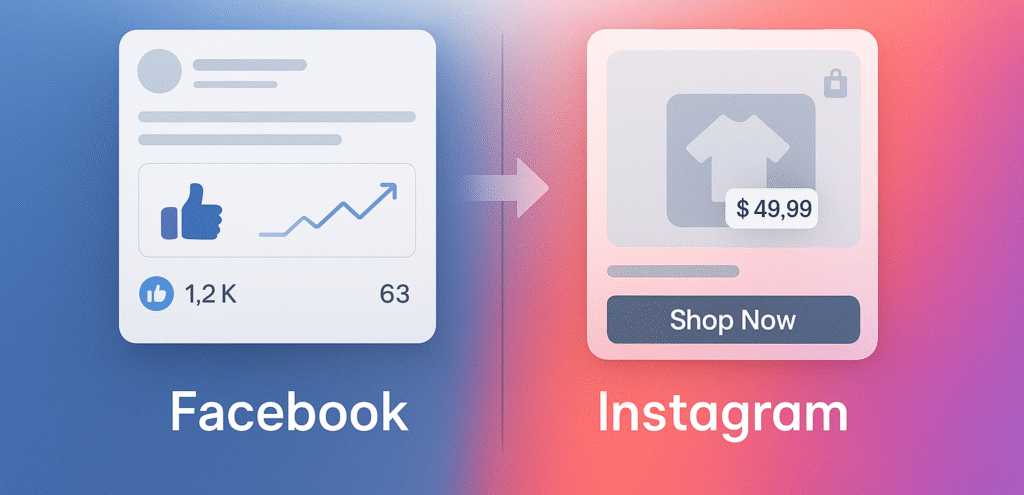
Click behavior on Instagram vs Facebook is shaped by ad targeting capabilities and copy quality, both essential for better conversion pathways.
On Facebook, likes fuel other engagement: comments jump 103.3% and shares rise 65.7%. Its algorithm rewards popular content across the news feed.
Instagram’s visual content, like shopping tags and Stories’ “Shop Now” buttons, drives sales-ready clicks. These tools fit mobile-friendly, scroll-based purchase behavior.
Understanding click-through rate differences helps tailor campaigns. Using real behavior data from both platforms ensures smarter ad spend and stronger outcomes.
Content Formats and Platform Strengths
Instagram vs Facebook content formats differ, giving brands unique ways to reach and engage their audiences based on platform-specific strengths.
Visual vs Textual Content
Visuals rule across both platforms. About 95% of marketers find images and videos more effective than text. Facebook supports detailed posts, articles, and comment threads, ideal for text-based content and deeper content consumption habits.
Instagram’s visual-first layout emphasizes photos and short videos. Users scroll fast, reacting with quick likes and short comments. Brands should tailor strategies: visual content on Instagram, detailed context on Facebook, adjusting for each platform’s strengths.
Facebook and Instagram Post Types
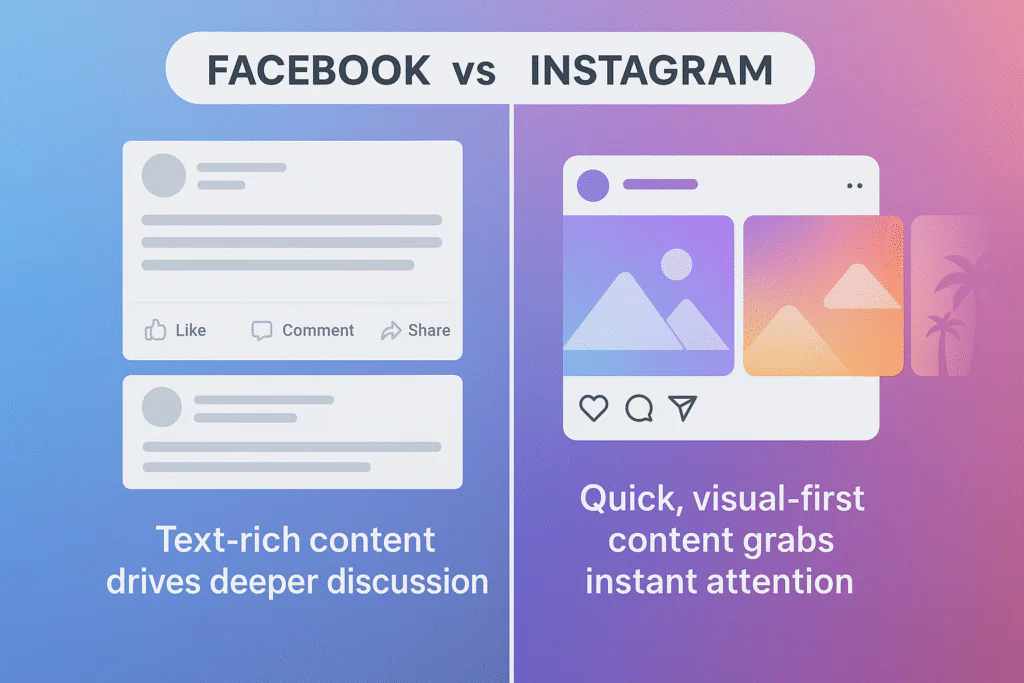
Each platform supports different content formats, helping brands connect in their own way. Instagram carousels increase engagement by 2.3-4% versus single posts. With up to 20 images or videos per carousel, brands can tell fuller stories. Users tend to swipe more, which helps the Instagram algorithm push the content.
In 2025, short videos lead on both platforms. Instagram Reels are central to video strategies. They now run up to 10 minutes, giving brands more time to deliver strong stories. Most videos are automatically shared as Reels, which helps increase reach beyond followers.
Facebook post types include:
- Text updates that spark conversations
- Links with eye-catching previews
- Hour-long live videos
- Extended video posts
Instagram shines with:
- Stunning photo posts
- Multi-slide carousels (up to 20 slides)
- Quick, engaging Reels
- 60-second Stories
Mobile-First vs Cross-Device Accessibility
Instagram follows a mobile-first approach, building its experience around phone users. With mobile traffic exceeding 50% of web use, this design choice fits user behavior. The app loads fast with compressed images and works seamlessly on smartphones.
Facebook, on the other hand, supports cross-device usage across phones, tablets, and desktops. Its features like the news feed, groups, and events, perform smoothly on all devices, especially desktops, where users can multitask and manage complex pages.
Algorithm Preferences: Engagement vs Recency
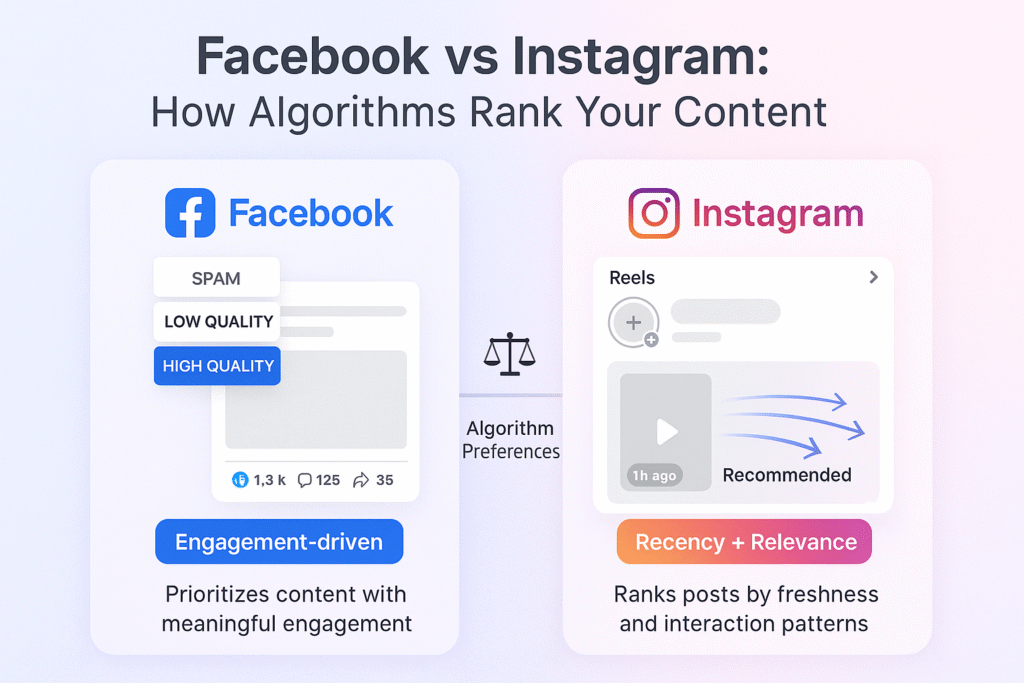
Both platforms use algorithms to decide what users see, but their priorities differ. Facebook boosts posts with high interaction, such as comments, shares, and reactions. It classifies posts as spam, low-quality, or high-quality. Only high-quality content gets wider visibility across the news feed.
Instagram’s algorithm focuses on four signals:
- How fresh the post is
- How often do you interact with the account
- What kind of content do you usually like
- How likely are you to engage with the post
Instagram Stories appear chronologically, starting with the most recent from followed accounts. For Reels, Instagram suggests videos based on past likes and predicted interests.
Regular posting helps creators on both platforms. Instagram prefers quick reactions to visual content, while Facebook prioritizes posts that lead to discussions. Each platform tailors visibility based on how users interact.
Advertising Performance and ROI
Spending on ads shows how Instagram vs Facebook differs in returns. The numbers offer clear insight into how your ad budget translates into results.
Cost Per Click
In 2025, Facebook gives better value with a cost per click (CPC) of $0.49 on average. In contrast, Instagram ads cost about $1.09 per click. This pricing gap affects how marketers allocate limited budgets.
Facebook CPC ranges from $0.26 to $0.97, while Instagram CPC runs between $0.40 and $1.73. For a better ROI, many advertisers prefer Facebook to get more clicks per dollar.
Industry matters too. Finance companies pay the highest CPC across social media, sometimes above $5. Education ads are lower, averaging $2.45 per click across both platforms.
Click-Through Rate
Click-through rate (CTR) data shows Facebook performs better, delivering 3.06 percent versus Instagram’s 0.68% percent. This leads to higher traffic and more conversions.
For ad formats, Facebook’s video ads in the feed reach a 0.33 percent CTR, followed by regular feed ads at 0.29 percent. On Instagram, Story ads lead with 0.76 percent, ahead of feed (0.69 percent) and explore ads (0.47 percent).
These figures impact your sales funnel. Facebook ads convert 9.21 percent of clicks into customers. In comparison, Instagram reaches only 1.08 percent. Even Google Ads trails behind at 3.75 percent conversion.
Ad Targeting Capabilities
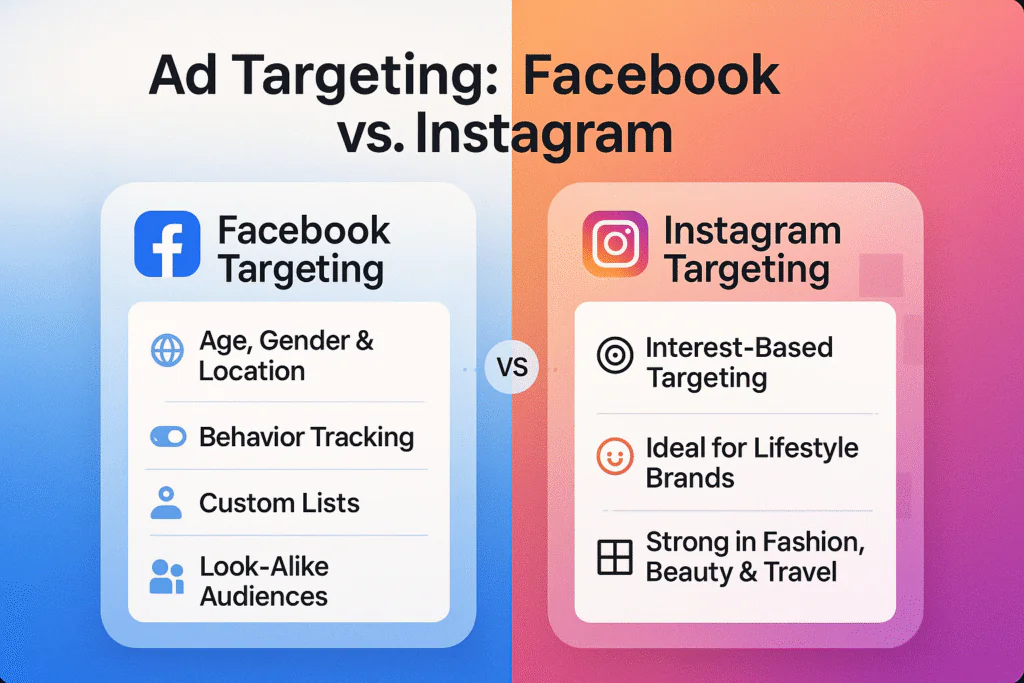
Both Facebook and Instagram rely on Meta’s advanced tools for audience targeting. However, Facebook stands out with deeper ad targeting capabilities. Facebook supports:
- Basic filters like age, gender, and location
- Tracking of user behavior on the platform
- Custom lists to target website visitors
- Look-alike audiences to find similar potential customers
This precision targeting works well for conversions. Users shown ads based on prior activity are three times more likely to engage.
Instagram’s targeting is more interest-based. It suits lifestyle brands and visual-first campaigns, performing best in fashion, beauty, and travel. While it has fewer options than Facebook, its audience tends to be more content-engaged and visually responsive.
Ad Types: Messenger, Reels, Stories, Feed
Both Instagram and Facebook support different ad types, helping businesses reach varied marketing goals. Facebook offers a wider range of ad formats.
- News feed ads featuring text, images, and videos
- Right column ads for desktop users
- Carousel displays for showcasing multiple products
- Messenger ads for direct customer interaction
- Marketplace listings to reach local shoppers
Instagram shines with its visual-first ad formats:
- Eye-catching feed images and videos
- Full-screen Stories that grab attention
- Engaging Reels for short video content
- Shopping tags that enable instant purchases
- Explore section ads for discovery
Studies reveal that short video ads, especially on Instagram, increase performance. High-quality creatives can raise sales by 12 percent. Strong visuals improve short-term sales by up to 7.4 times and long-term sales by 2.7 times.
Many marketers now use Meta Advantage+ Placements to run ads on both platforms automatically. This approach saves budget and improves conversion opportunities across all placements.
Conversion and Sales Capabilities
Both Facebook and Instagram provide distinct e-commerce features that help convert engagement into sales.
Facebook Shop vs Instagram Shop Access
Facebook Shop gives open access to all businesses. Instagram Shop is more selective, with tighter entry rules. Both introduced these tools to help small businesses grow their online sales.
Facebook allows US businesses to sell directly from their pages. Customers can browse and check out within the platform. Instagram requires meeting criteria to unlock full shop features, making Facebook easier for newer brands in social commerce.
Linking Options
Facebook supports multiple external links, promo codes, and direct sales elements in both posts and ads. In contrast, Instagram limits users to a single link in the bio.
This restriction has sparked the creation of many “link in bio” tools that help creators share multiple links through a single bio link. These tools let Instagram creators promote different content types at once, from blog posts and videos to products and subscription offerings. This key difference makes Facebook more effective for driving direct website traffic.
Swipe-Up and Shopping Tags
Instagram offsets link restrictions with visual shopping tools. The Swipe-Up feature in Stories leads users directly from content to product pages.
Instagram’s product tagging, now available to all US users, lets anyone tag products in their Feed. These tags link to product pages, turning Instagram’s visual interface into a smoother shopping experience.
eCommerce Integration: Shopify, BigCommerce.
Both platforms integrate with leading e-commerce platforms like Shopify. Business owners can sync products, manage inventory, and handle payments across Facebook, Instagram, and their main store from one dashboard.
BigCommerce also allows brands to turn Instagram posts and Stories into shoppable content. Both platforms now support in-app checkout for US customers, simplifying the path from product discovery to purchase.
What Are The Benefits of Facebook Over Instagram?
Let’s look at why some marketers may favor Facebook in the Instagram vs Facebook debate. These benefits show how Facebook stands out for certain business needs.
- In the Instagram vs Facebook comparison, Facebook has the larger user base. It ranks as the second most-visited website globally.
- Facebook appeals to users across multiple age demographics, including Gen X and Baby Boomers. Its wide acceptance gives brands a better chance at visibility across different audience segments.
- The platform’s business-friendly environment includes support for multiple direct links in posts, helping drive traffic and conversions effectively.
- Facebook can schedule Facebook group posts using the built-in Facebook schedule post feature.
- Facebook Ads work well, especially when creatives are optimized for engagement and targeting precision.
- On Facebook, video content typically outperforms photos in clicks and views, particularly among mobile users.
- Instagram followers are more engaged and valuable than Facebook followers.
What Are The Benefits of Instagram Over Facebook?
While Facebook has its strengths in the Instagram vs Facebook analysis, Instagram shines in ways that give brands fresh opportunities to connect with their audience.
- Instagram is ideal for reaching younger demographics, especially Gen Z and Millennials, who favor visual-first platforms.
- Its visual orientation makes it a great match for content in fashion, beauty, design, and other creative industries.
- A large share of Instagram users make mobile purchases, and their average spend tends to be higher than on Facebook, offering strong e-commerce potential.
- With nearly 72 percent of marketers running ads on Instagram, it remains a top pick for businesses focused on visual engagement.
- Verified accounts on Instagram hold more credibility and give more potential to businesses to increase their reach. Most verified accounts were found to have over 1 million followers. Find out how to get verified on Instagram and get ahead in the game. Instagram followers are more engaged and valuable than Facebook followers.
How RecurPost Can Help in Running Campaigns on Facebook And Instagram
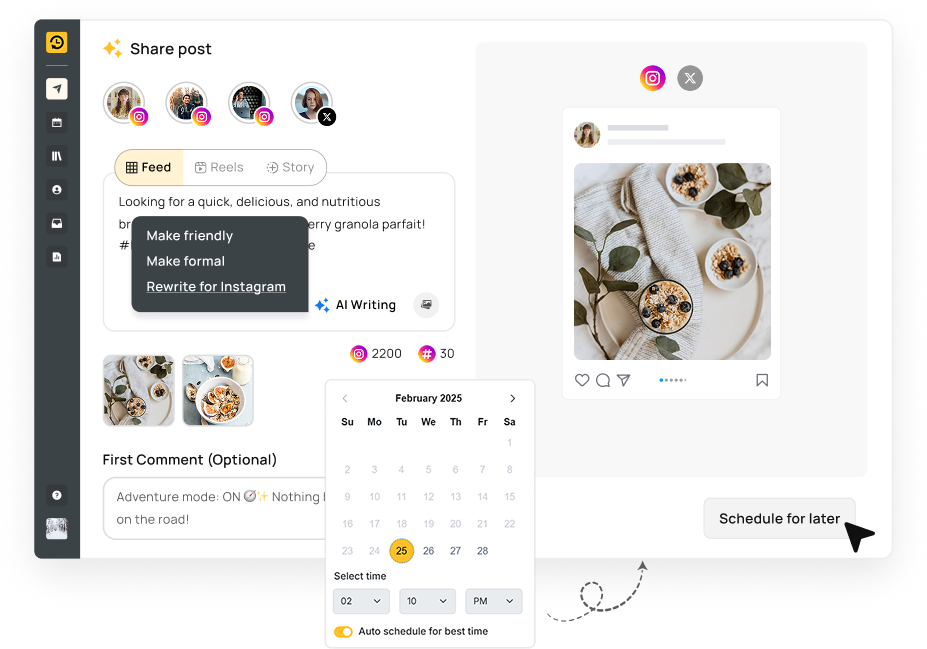
Content timing and algorithm understanding are essential for social media visibility.
A social media scheduler boosts consistency by handling planning, post timing, creative management, and content organization on both platforms.
RecurPost simplifies campaign management on both Instagram and Facebook. It offers top tools for scheduling, tracking, and analyzing social campaigns.
Among Facebook Marketing Tools, RecurPost stands out with powerful automation features. It helps maximize engagement and improve your brand’s visibility.
Conclusion
Facebook and Instagram offer distinct marketing advantages. Choose your content strategy based on specific goals rather than assumptions.
Evaluate your content skills, audience type, marketing budget, and campaign goals when selecting between Instagram and Facebook. Use the 2025 insights and metrics shared in this guide to make informed social media marketing decisions.
FAQs: Instagram vs Facebook
1. Can I run the same ad on both platforms with one campaign?
With Meta Ads Manager, you can set up one campaign that runs across both Facebook and the Instagram app. Just make sure your visuals and text are optimized for each platform’s unique audience and format.
2. Is there a big difference in how people use direct messages on Instagram vs Facebook?
On Instagram, direct messages feel more personal and are often used for quick responses or influencer outreach, while Facebook supports deeper conversations, especially for customer support and community building. Tailor your communication style based on how users engage on each platform.
3. Are Facebook Stories still effective, or should I focus more on Reels?
Facebook Stories continue to perform well, especially among older users. Instagram Reels work better for fast-paced engagement. Use both based on your content type and target demographic.
4. Should I bother posting text-only posts on Instagram?
Text-only posts don’t perform well on Instagram, which is built for visual content. However, Facebook supports this format, and it often sparks conversations, especially in groups or community pages. Keep your Instagram account image-focused, but go ahead with text-driven, relevant content on Facebook.
5. How can I measure if Instagram ads are outperforming Facebook ones?
Use Facebook Insights and Ads Manager to compare performance side-by-side. Look beyond clicks, track conversion rates, engagement, and return on ad spend to decide which channel delivers better results for your paid advertising goals.
6. Do both platforms offer the same targeting options for paid campaigns?
They share the same backend tools, but audience behavior varies across these social media networks. To get the most out of your ad spend, create variations of your ads tailored to how users interact differently on each platform.

Shalini Nagar is an experienced content writer with a proven track record of creating diverse and engaging content across various formats. With years of expertise in crafting blogs, articles, she excels at delivering compelling narratives tailored to different audiences.

